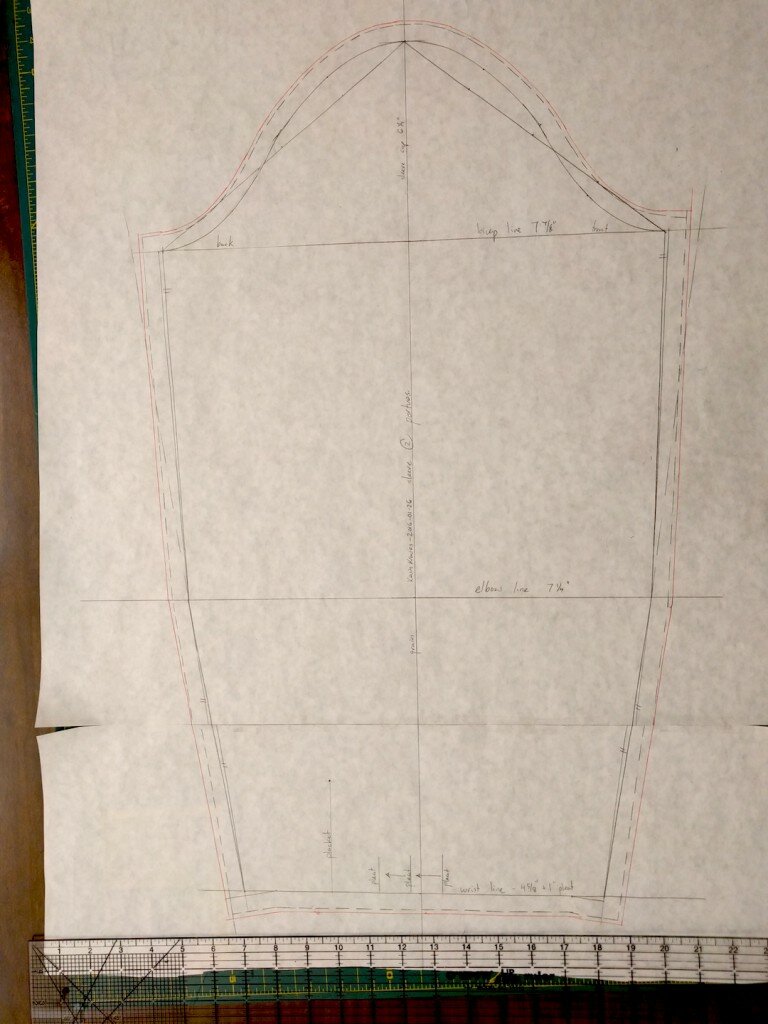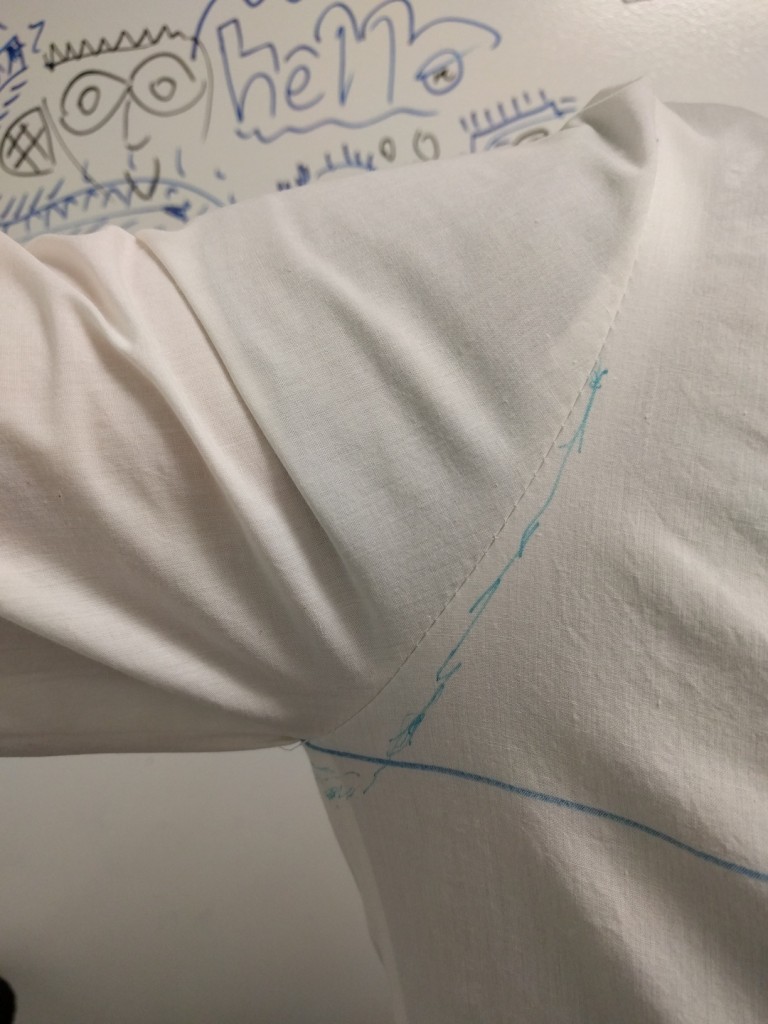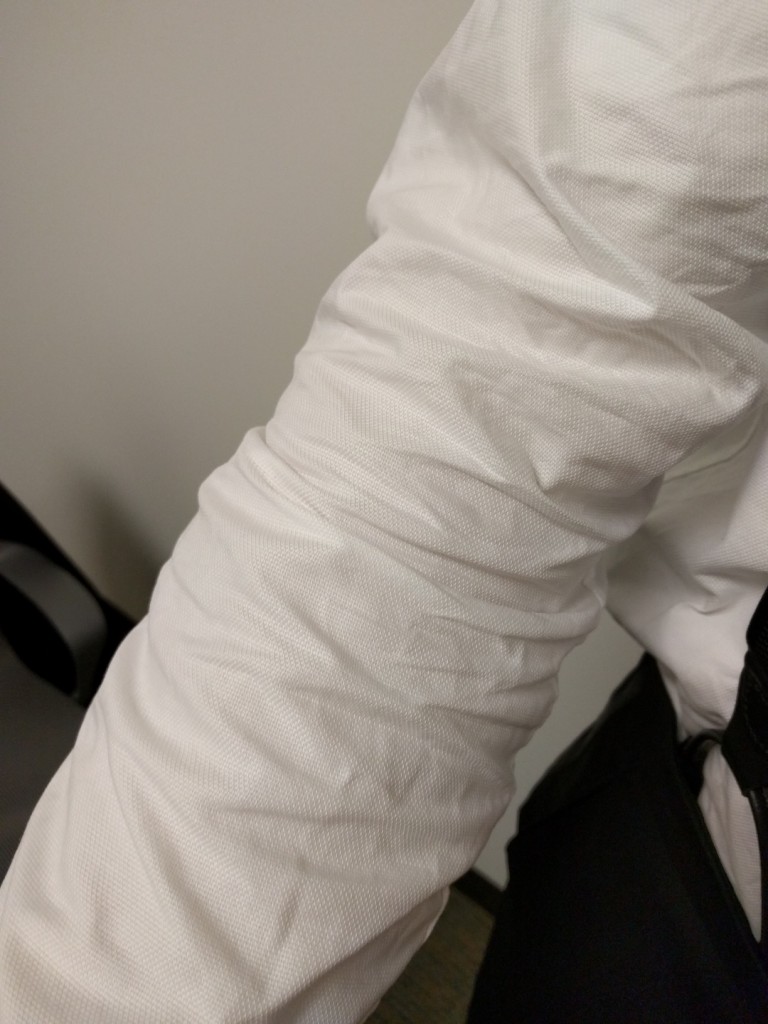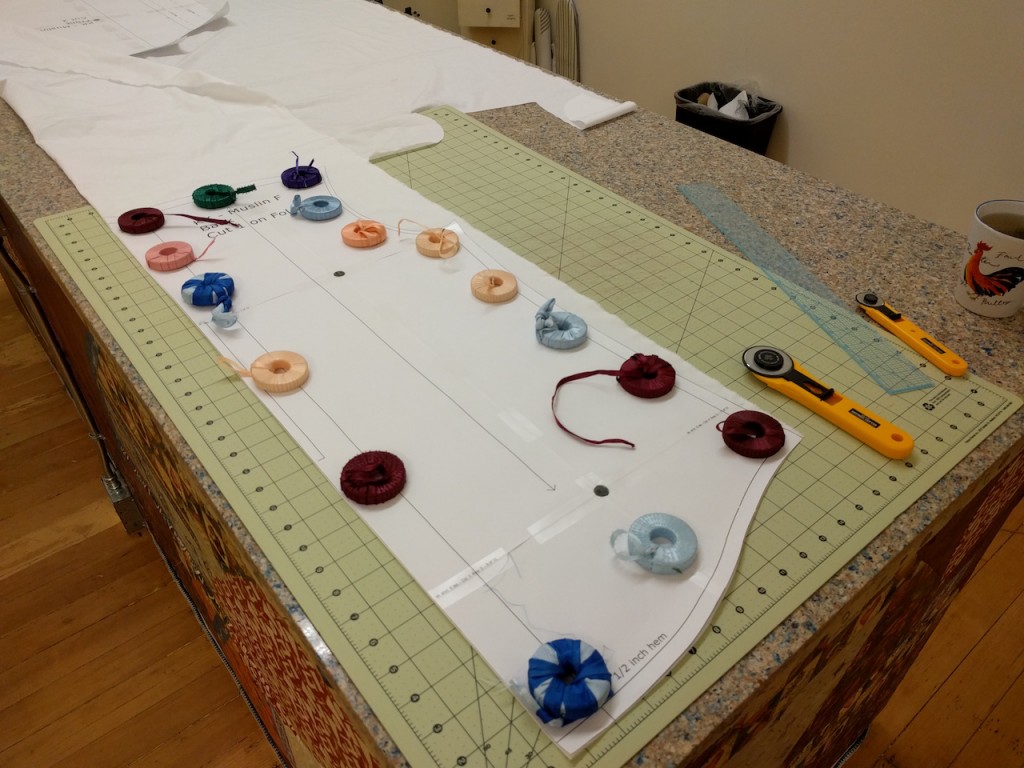I’ve been devoting so much time to my Tuxedo Shirt project that I haven’t had time to blog as I go. I’ll fill in more details after the job is done, but here’s an update in the interim.
Fitting
After several rounds of fitting, the good news is that I’ve arrived at a shirt pattern that fits the client.
I got a trial-by-fire lesson in sleeve fitting, which I had not had a chance to practice on myself before trying out on the client. After draping the muslin and tracing out the client’s armscye directly on the muslin, I drafted a new sleeve to match.
I started by making a new sleeve pattern, using a draft I learned in Paul Gallo’s patternmaking and design course I took in January. Contrary to the original sleeve that came with the model shirt, and also contrary to many men’s dress shirts, I used a much higher sleeve cap based upon measurements from my client.
Here’s the first sleeve draft that I produced; it was a little tight around the bicep and the wrists because I didn’t get the measurements right. But you get an idea of the overall shape of the sleeve cap. The solid pencil is the stitching line, I added both 1/2 inch (dashed) and 5/8 inch (red) seam allowances.
The second revision of the draft wasn’t much better. It fixed the problems with ease around the biceps and added some more width for the cuff, but the client had mobility issues reaching forwards (as if grabbing a steering wheel) and backwards.
With the shirt on the client I split open the armscye seams, and pinned much narrower seam allowances to add ease at both front and back shoulder. This resolved the front/back freedom of movement issue, but there was still another problem – when the client raised his arms, the entire shirt pulled up with a weird twist line across the bicep.
(Ignore the light blue line; I never did anything with that).
Later, inspecting the pattern, I noticed that I had lowered the armscye about an inch in front, but due to a mistake I made transferring from muslin to pattern, I had never lowered the back armscye by a corresponding amount. So that meant a smaller-than-expected armhole that was out of balance front to back.
Secondly, I measured and compared the my drafted sleeve inseam compared to the original pattern trace. The sleeve inseam on my pattern draft came up short. Separately, I came across the following diagram via Pinterest that illustrated the problem and its solution (lower right diagram):
I altered the draft to add an inch and a half of extra length to the sleeve inseam. Combined with lowering the back armscye, this enlarged the armscye, adding an inch or two of overall ease around the bicep which the client was asking for anyway. The alteration flattened out the sleeve cap a bit, but the sleeve cap is still taller than the original shirt trace, but it still looks good and the client is happy with fit.
Final Tryout
I made what I thought was a final shirt for the client. I skipped plackets and cuffs and basted in the sleeves because I hadn’t yet checked the sleeve fit, but the plan was to go back and finish the sleeves after the fitting and tryout. Everywhere else I invested the best care and detail I could muster.
We’ve done a fitting and tryout with the full tuxedo outfit. Kevin, my client is happy with the fit, details, styling and construction. So why don’t I have a finished shirt and a happy client?
Here’s why.
The fabric is a bit on the heavyweight side for a dress shirt, but that didn’t pose a big problem during construction. The real problem is that for a shirting fabric, it doesn’t have enough drape, and is very stiff. It feels more like an exquisitely made quilting cotton. It wrinkles very easily, they show up very prominently, and they never recover.
In the above photo, the client made all those accordion-like wrinkles in both sleeves simply by putting on the shirt and tying his bow tie. And two days later, after carrying the shirt all over town in my bag, the accordion wrinkles still persist:
I invited Mark, a style-conscious coworker who is quite knowledgeable about menswear, to our shirt tryout session in order to get his unbiased opinion. He was initially okay with the shirt and didn’t think wrinkling would be an issue, but after seeing the accordion wrinkles on the sleeves he changed his opinion.
There’s no way the client would look fresh in that shirt for even the first few minutes, let alone a full wedding day. All three of us – maker, client, and style consultant – agreed that this was the right shirt, made in the wrong fabric.
I had purchased a cut of high quality Pima broadcloth fabric from Britex Fabrics that had been intended for a wearable muslin. That never got made because the fitting issues went on way longer than expected. I’m pretty sure the Pima broadcloth was one of the original fabric candidates we considered, and with the client’s blessing on the fabric switch I’ve set off to make a completely new shirt.
I spent last evening at the Sips N Sews studio using their expansive worksurfaces, and decorative pattern weights, to cut all the pieces for the new shirt.
I’ve lengthened the shirt tails in front and back by about an inch to better facilitate being tucked-in to the tuxedo trousers, but other than that there are no pattern changes.
The wedding is next Saturday. I have basically this weekend to complete the shirt.
This is my very own “Make it Work” moment!






No doubt there’s no time for experiments, but I keep thinking that heavy textured fabric would be lovely for formal collar and cuffs, and maybe even a full or partial front panel, built on the more comfortable, forgiving body and sleeves from the pima…?
Hope you’re managing to have some fun with this project, along with all the learning:)!
David,
I was thinking about that this morning – here’s a video: https://www.youtube.com/watch?v=LDWAq-Jy_mM At 3:10 and 3:17, you can see the model is wearing a shirt with cuffs made from a textured fabric, matching the bib of the shirt.
I just ran the idea past the client – I didn’t ask about a bib because I know he doesn’t want it. But he said yes to collar and cuffs made from the heavier, textured fabric. The two fabrics have only a very slight difference in their white tones so it will work well. And this will make a look you won’t (easily) find in a RTW shirt.
So that is the new plan.
Good luck this week with your project’s new direction!
I have been sewing granddaughter project dresses to get my skills up to sew my own shirts and other clothing. I am enjoying reading about your progress.
John Thomas in NC
Thank you for the kind wishes. I’m looking forward to seeing how the project’s new direction turns out myself!
I hope everything goes smoothly now that you have the major issue sorted out. Looking forward to see the finished product!
Thank you! Sleeve plackets went in last night, I’m hoping to attach cuffs and sleeves this evening.